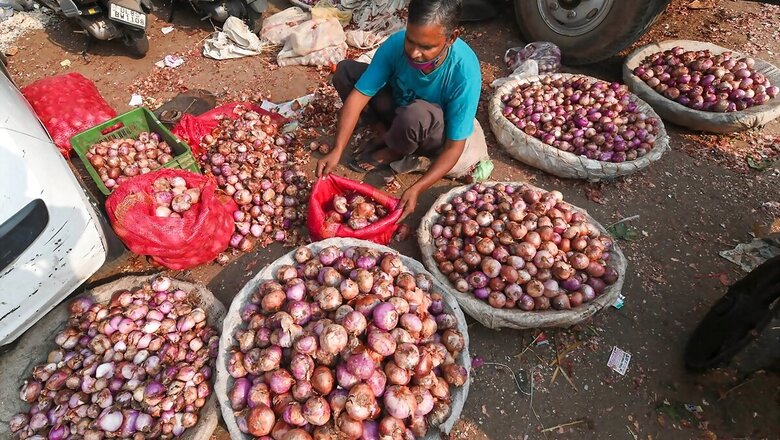
views
In the wake of damage to standing Kharif crop in producing areas due to heavy showers, onion prices have shot up sharply. In the last few weeks, the price of the bulb has remained above Rs 80 in several cities, with consumers continuing to feel the heat. Bhaskar Natarajan, CEO of agribusiness research and information company Agriwatch believes that the main reason for high volatility in onion prices is the uncertainty of the production of the kitchen staple in the Kharif season. In an exclusive interview with News18, Natarajan speaks on a range of issues concerning the soaring onion prices, including, cyclical pattern of onion prices, export bans and cartelisation of wholesale markets.
Edited Excerpts:
1. What is the main reason for such high volatility in onion prices?
The main reason for high volatility in onion prices is the uncertainty of onion production in the Kharif season. To understand this, we need to understand the seasonality of onion production in India.
Onion is produced during three seasons in India – (i) Rabi onion (including unhali in Maharashtra) is produced between early March to end of May. It is primarily produced in Maharashtra and Madya Pradesh. (ii) Kharif onion which arrives from early September until November and (iii) late Kharif onion which arrives from mid-December until late February. The breakup of the onion production for these periods is roughly 60%, 20% and 20% respectively of the total annual production.
Of these, only the Rabi crop can be stored for a reasonable period of time (six-eight months). Both the Kharif and late Kharif crops cannot be stored for more than a few weeks. The stocking of Rabi crop is usually done by the end of May or early June by farmers as well as traders. It is then gradually released until it is depleted by mid to late-December.
Thus, the demand for onion is met solely by Rabi onion from March to August end, by a combination of the stored Rabi crop and new Kharif crop from September to mid-December and by the late Kharif crop from mid-December to end of February.
Usually, the Rabi crop is good. It may fluctuate up or down by 15-20% year-on-year but by and large, it is sufficient to meet the demand at least up to mid-October. The uncertainty arises whenever there is negative uncertainty regarding Kharif crops (i.e. damage or delay in arrivals). If there is significant damage to the Kharif crop, it increases the burden of supply on the stored Rabi crop. With smaller Kharif onion arrivals, more of the stored Rabi onion is consumed and it may get depleted by Oct-Nov itself instead of the usual December. The Kharif crop is the most uncertain and unpredictable crop because it is could be affected by either excess rains or drought during the monsoon season. Or it could even remain unaffected. The growing conditions of Rabi and late Kharif crop are comparatively more predictable or at least more manageable.
The biggest hindrance is that if there is going to be damage to the Kharif crop due to excess rains, but the extent of damage to the Kharif crop can only be positively confirmed in late August. This is because when there is damage in June-July, the farmers have enough time to do re-sowing of the crop. However, after mid-August, the window for sowing ends for the Kharif crop.
So when it is finally assessed in late August that the Kharif crop is definitely not going to meet the requirement, the prices start rapidly rising because everyone comes to know that the market will have to depend more on the previously stored Rabi crop. Thus when a volatile year happens, prices usually start rising in August-September and remain high until November-December depending on the extent of damage to the Kharif crop and the size of the previous Rabi crop. If the previous Rabi crop was smaller than usual, the price rise is magnified. If the previous Rabi crop was larger, then the price rise is mitigated (though prices will still rise, but not as much as the case when the previous Rabi crop was smaller). Usually, prices start falling in late December or early January with the onset of the late Kharif crop.
2. Would you agree that there is a cyclical pattern as far as onion prices are concerned? Roughly speaking, once in every three years, retail onion prices either hover around the Rs 90/ mark or cross the Rs 100/- mark and almost always in the winter season. What explains this?
The cyclical pattern is usually seen every two years rather than three years and is observed among many crops, particularly perishables. It just attracts more attention in the case of onion. The cyclical pattern arises because when farmers see the price of a crop was good last year, they tend to sow more of the crop in the current year, leading to oversupply. Conversely, when they didn’t receive a good price last year due to oversupply, they tend to not sow it this year leading to lower production. Not all farmers do this. Around 80-90% of the onion farmers sow onion every year, but the rotation of crop by the remaining 10-20% of farmers is enough to cause swings of up to +/-30% in crop production from one year to the other.
It should be noted that the weather also plays a big factor in this. Let’s suppose 10% of farmers have not sown onion this year because of poor prices in the previous year. If the weather during the growing season is very good, then it compensates for the lower sowing area. e.g. If the area of onion sown is 10% lower, but due to good weather the yield or productivity (production per hectare) goes up by 10%, then the production remains roughly same as last year despite 10% lower area. On the other hand, if the weather was poor, it exacerbates the situation. For example, if area sown is 10% lower and there is bad weather on top of it, then the productivity may also be lower by 10% from the previous year. Due to this, the production is approximately 20% lower than last year though the area is only 10% lower.
As mentioned in the previous question, the price rise typically happens in the September-December period and is due to the insufficiency of the residual Rabi crop and the new Kharif crop to meet the demand in these four months. Cyclical production can play a part — if the Rabi crop was smaller due to cyclicality and the Kharif crop suffered even a relatively small amount of damage (say 10-20%), it would decrease the available supply between September and December and cause higher prices. On the other hand, if the Rabi crop was larger due to cyclicality, it would require a large amount of damage (30-50%) to the Kharif crop to trigger higher prices (as is the case this year).
3. High retail prices are just one part of the story. The other part is when prices crash due to various factors, like overproduction, putting the farmers in peril with wholesale prices at Re 1 per kilo. What can be done to protect the interests of the farmers?
Unfortunately, when a perishable crop like tomato or onion faces large overproduction due to the cyclical sowing pattern by the farmers, the measures that can be taken are rather limited. This is because once harvested, it has to be consumed within a couple of weeks. This precludes the possibility of the government procuring it to support the price as in the case of grains, pulses or oilseeds. In the case of Rabi onion, which has better storability, NAFED has procured over 100,000 tonnes in each of the last two years to support prices during the Rabi season as well as to build a buffer for the contingency of a price spike later in the year – a contingency that has materialised in both these years coincidentally! So this 1,00,000 tonnes buffer can be continued every Rabi season and will provide price support to farmers. It cannot be done with the Kharif and late Kharif onion (or other perishables) since they cannot be stored for long.
The second option is to encourage the evacuation of excess production from the producing centres to the consuming centres. This is also being done in the last two years under the Operation Greens scheme which offers a 50% subsidy on transportation and storage to transfer the excess production to the consuming centres. This is conceptually a very good scheme and needs to be strengthened.
The third option is to encourage exports so that the surplus is sent outside the country. This has its own challenges which are an entirely different subject matter.
The fourth option is to increase processing of the perishables. However, unlike the developed countries where large quantities of perishables are processed into forms which can be stored longer (canned, frozen, products, etc), the Indian consumer prefers to consume fresh vegetables and fruits and does not prefer canned or frozen vegetables and fruits due to taste-related perceptions.
The fifth option is to give better advisories to farmers to avoid cyclical production so that gluts can be avoided or at least the magnitude of the gluts could be reduced. I have read reports where Niti Aayog is working in this direction to provide better advisories to farmers so that cyclical production can be avoided and production can be matched with the demand as best as possible. This initiative needs to be accelerated and persisted with.
The fourth and fifth options are long term measures but are more sustainable solutions and have the potential to sustainably solve the problem of low prices due to cyclical overproduction.
4. The government has taken many measures to ensure stability in prices in the retail market. Creation of buffer stock is one important measure. In your opinion, is this enough or more needs to be done? For instance, perhaps every state also needs to create a buffer stock?
The creation of the one lakh tonne onion buffer stock by NAFED in the last two years has proved to be very timely. Both last year and this year, the price situation would have been much more problematic if it hadn’t been for the Nafed buffer stock. State governments could also consider building smaller buffer stocks in their states. However, another option which needs to be considered and which hasn’t received the attention it deserves is the diversification of onion production to more states across the country.
Currently, the entire country is predominantly dependent on Maharashtra and Madya Pradesh for Rabi onion and Maharashtra, Karnataka, Andhra Pradesh, MP, Gujarat and Rajasthan for Kharif and late Kharif onion.
Any untoward weather incident – particularly to Kharif onion in Maharashtra and Karnataka – results in spiralling prices. If states like Punjab, Haryana, UP, Bihar, Odisha, Chhattisgarh, etc could increase their share in the onion production, particularly Kharif onion crop, the production will be much more diversified and thus less susceptible to regional weather vagaries. The dependence on Maharashtra and Karnataka for Kharif onion is simply too high from a risk-management perspective.
5. Another important factor is the export of onions. In the years that we have seen prices spiralling, there seems to have been a delay in imposing either an export ban or raising the MEP of onions. And then, the government scrambles to import. It takes a minimum of two months for imported onions to reach Indian markets by when there are fresh arrivals from fields in India. Can we explain, with data, how much onion was exported and then, what quantity was imported?
Frankly, I believe that imposing export bans should only be done as a last resort. When we impose sudden export bans, the overseas customers of Indian onions have to suddenly scramble to find alternate sources of onion. This will make them perceive India as an unreliable supplier and will hurt our important longer-term goals of increasing agricultural exports. Perhaps we could consider quantitative restrictions on exports instead of outright bans.
As explained previously, any emerging shortage in the country can only be determined in late August when the extent of shortfall of Kharif onion can be assessed. The bulk of the exports of onion from India are of the Rabi variety and between March to August, typically almost 2/3 of the annual exports have already taken place. Any export ban before August would be premature and speculative in nature and could hurt the Kharif onion farmers exactly when their crop arrivals are about to begin in September if the anticipated shortage doesn’t materialize.
In any event, the exports that take place between September and December is only around 5 to 10 lakh tonnes out of the total production of 220-250 lakh tonnes. Even if you were able to accurately forecast an emerging shortage and banned exports a month sooner than otherwise, that would only result in an additional availability of approximately 1 to 2 lakh tonnes compared to a later export ban decision.
That is negligible when you compare it to our monthly domestic consumption requirements of 12-14 lakh tonnes. The maximum amount of onion we can hope to confine within the country as a result of even an early export ban is not more than 10 lakh tonnes between September to December which is the problematic period. A much better option would be to encourage additional production of this 10 lakh tonnes (and preferably around 20 lakh tonnes) during the Kharif season in other non-traditional states so that we do not need to ban exports in the first place.
6. We often hear of cartelisation of wholesale markets, especially in Maharashtra. There is a report commissioned by the government which has delved into this. To what extent, you feel, is cartelisation responsible?
In general, I do not believe cartelisation is the root cause of any price increase in any major and widely produced commodity like onions. It is definitely a factor in intensifying or exacerbating the price increase, but cannot by itself be the root cause of the price increase. There has to be a real shortage in the first place for cartelisation to be able to capitalize on it. That said, all forms of cartelisation are unethical and illegal and as and when detected should be strictly dealt with as per the law.
7. Can we explain, in detail, the nature of this year’s volatility – damage to crop due to rains, shortage in supply, volume of onion that has been exported, short-term interventions by the government like the imposition of stock limits?
The price increase this year is primarily due to severe damage to Kharif onion production in Maharashtra and Karnataka. Both these states experienced large excess rainfall and flooding in major onion growing districts and various damage estimates are of the order of 30-50% of the Kharif onion production in these states (even higher damage is reported by some sources in Maharashtra). Even other growing states like AP and Gujarat have reported damage, though not to the extent of Maharashtra and Karnataka. Only Rajasthan and Madhya Pradesh Kharif onion appears to be unscathed. In Maharashtra, the reports we are getting indicate that the damage occurred in waves one after the other. Farmers had re-sown after the first damage incident only to have it damaged a second and third time and so forth. There were reports of damage even to seedlings in nurseries which resulted in seedling availability issues for re-sowing.
Thus, despite a record Rabi production earlier this year, the damage to Kharif onion in the two biggest producing states of Maharashtra and Karnataka has more than offset the bumper Rabi crop. In addition, there is some uncertainty about the size of the late Kharif crop in Maharashtra due to seedling availability issues caused by damage to nurseries.
As far as exports are concerned, during the March-July period last year, the exports were 9.38 lakh tonnes while the exports during the same period this year stand at around 11.08 lakh tonnes. March is taken as the starting month because that is the beginning of the Rabi crop arrivals and because only Rabi onion is exported. Thus exports were higher by only 1.7 lakh tonnes compared to last year for the March-July period. Thus, it is not a significant contributory factor to the current high prices, which as described above is primarily due to the widespread damage to Kharif onion in Maharashtra and Karnataka.
The response of the government has been faster this year in terms of the export bans – September 14 this year compared to September 29 last year. Also, imports seem to be happening earlier this year than last year with reports of 7,000 tonnes of onion already imported and another 25,000 tonnes expected before Diwali. The imposition of stock limits will also help weaken whatever opportunistic cartelization is taking place to take advantage of the shortage situation. So on the whole, the response this year has been more pro-active and faster than last year.
However, from a sustainability perspective, it would be much more beneficial to diversify and increase Kharif onion production in other non-traditional states so that crop losses in Maharashtra or Karnataka do not hurt so much, so that an additional 10-20 lakh tonnes is available in the Kharif season from alternate sources and so that we do not need to ban exports in future.
Read all the Latest News and Breaking News here



















Comments
0 comment